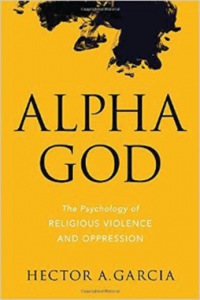Alpha God: The Psychology of Religious Violence and Oppression

Hector A. Garcia’s new book, Alpha God: The Psychology of Religious Violence and Oppression, successfully draws parallels between violence in human evolution and in dominant religions. He effectively illustrates the salience of the connection with contemporary examples of religiously inspired violence around the world.
While Garcia concentrates on Judaism, Christianity, and Islam, his target is the legitimizing of violence by any religion. “History reveals in striking form how men have historically conflated themselves with God as a means to amplify power,” he writes, “and how male gods rise to totalitarian rule in the manner of men—through violence and killing.” Garcia deftly details analogies between specific religious rituals or doctrines and human cultural and evolutionary structures of dominance in primates, including tribal, territorial, physical, sexual, patriarchal, and social dominance structures.
To be clear, Garcia’s sources for religious ritual and doctrine are principally present-day religious canons. He does not include what might be called the “human interpretations” of the canons, i.e., the rabbinic tradition, the encyclicals, the hadith, and so on. Garcia stays away from the question of what the real faith in any religion is. In that way, Alpha God develops only part of the picture. At the same time, some of his human examples unhelpfully fall into the category of nonreligious culture.
Nonetheless, social media are full of arguments even amongst humanists about whether Islam is inherently violent compared with, say, Judaism or Christianity. With respect to the canons of the religions, Garcia’s analysis, properly publicized, would settle that debate. While he acknowledges the role of cooperation, he shows how the canons of all three Abrahamic religions are centrally designed around domination through violence. In that light, religionists who consider the Torah, the Bible, or the Koran to be the word of God have a crushing burden in proving their claim that their God is purely a loving, tender deity.
Of course, many followers of those religions do not consider the descriptions of violence and oppression in their religion’s canon to reflect religious doctrine. Those religionists will consider Garcia’s portrayal inaccurate as they cherry-pick the decent parts in arguing otherwise. What they’re really talking about is their own personal religion, not the religious doctrines of the respective canons.
This aspect plays into current debates about whether violent individuals and groups claiming the mantle of Islam, Christianity, or Judaism are Islamic, Christian, or Jewish, respectively. The fact that the canons of these religions include violent and oppressive narratives are reason enough to reject them. When followers selectively create their own positive spin, it is better than sanctifying the whole canon, without a doubt. But the truth of the matter is that these followers are reinforcing the legitimacy of the violent and oppressive parts of those canons for those who would use them to justify violent, oppressive, and hegemonic acts of self-interest. Garcia aims to unlink the good from the bad: “Once the biological mechanisms underlying moral hypocrisy are recognized, it may make it easier to disallow sociopathic behavior, even when it occurs outside the boundaries of our immediate circle.”
That leaves a key observation. Part of the discussion about violence in the name of religion is whether peaceful religionists have any special duty in the fight against violence in the name of their own religion. While peaceful religionists cannot be expected to root out terrorists themselves, they are in a unique position when it comes to Garcia’s “disallowing.” As insiders to their religion, they arguably are in a unique position to take a stand against harmful religious extremism. They have a duty to publicly repudiate the violent parts of their religion’s canon and those who use those parts to justify their violence.

“St. Michael” by Luca Giordano, 1663 (Public Domain via Wikimedia Commons)
As useful as it is on that point, Garcia’s book does not attempt to explain why religion exists or why religion is the way it is. Garcia does not argue that all religions utilize ritual and doctrine infused with violence and psychological dominance to such a great extent, nor does he address arguments about why those religions that do use violent tropes are the way they are. At most, he correlates the evolutionary psychology of violence with religious dogma and practice. But correlation is not causality. He presents no evidence or argument to establish any causal connection between the two. Instead, he leaves it up to the reader to ponder possibilities. Properly assessing the role of violence in the existence of religions or even in the nature of a particular religion would take much more evidence and analysis.
Instead, in Alpha God Garcia seeks the laudable goal of freeing religionists from the limiting doctrines of religions that provide a cover for those (mostly male) individuals with violent tendencies. The classic example is the commandment to not kill. Garcia goes one step beyond prior scholars who pointed out that it only applies to the faithful: he ties the statements of doctrine in the Torah, Bible, and Koran calling for the slaughter of nonbelievers to the wantonness of groups of primates in killing members of other groups of their own species.
One major bone to pick is that Garcia almost completely ignores prejudice or violence against nontheists and atheists by adherents of Judaism, Christianity, and Islam. That behavior is obviously a form of tribal dominance, but it doesn’t appear in his discussion of that form of dominance. He only briefly addresses it in the context of heresy as another form of suppression, and yet, to one degree or another, the Abrahamic religions consider nonbelief to be more threatening than belief in a competing religion. Garcia’s blind spot may show as well as anything how deep the prejudice goes.
One minor bone to pick is with the title. Garcia rightly includes territorial and tribal dominance in his analysis; however, strictly speaking, they pertain to the religion more than to the deity. He acknowledges that tribal dominance drives competition between groups of primates and humans. Territory also pertains to group control. By depending on the group, those forms of dominance call forth loyalty to the group, not the deity. Those forms of dominance have been important to the rise and success of the Abrahamic religions because they undergird the importance of converting nonbelievers to group membership. Catholicism, for example, still considers itself the only true religion, and within Islam, some Sunni sects consider Shi’ias to not be Muslim. In this vein, Garcia might have titled his book something like Alpha God, Alpha Religion.
In the same vein, that Judaism, Christianity, and Islam exhibit high levels of reliance on violence in ritual and doctrine is remarkable enough. But the fact that they all have the same deity shows the extreme to which these monotheisms are fundamentally hegemonic. Garcia missed this point amidst his focus on domination by the god, but not the religion.
Alpha God does provide insight into how to explore the connection between basic human traits shared with primates and the success of the Judeo-Christian-Islamic tradition in the religious marketplace. Anyone who wants fleshed-out documentation of the origins and history of Christopher Hitchens’ attacks on religious violence should read this book. And if it opens the eyes of even one religionist to the connection between religion and violence, then it will have made the world a better place.
